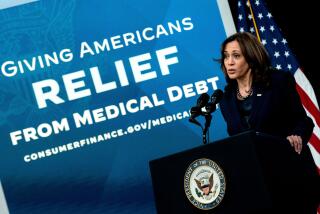DEFICIT : To Pay Off Debts, Uncle Sam Even Accepts Spare Change
- Share via
WASHINGTON — When it comes to big government, the biggest numbers are laden with bad news. Take the $3.9-trillion national debt. Or its poor cousin, the $400-billion budget deficit.
Please.
Yet for those Americans who want to make a personal stand against the country’s vast and debilitating monetary obligations, there is a way. Send your checks, send your bequests, send your loose change to Washington, and the folks at the Bureau of Public Debt will cheerfully deposit it in a special account designed to whittle away at the debt, bit by bit, however long it takes.
BACKGROUND: Called “Gifts to Reduce the Public Debt,” the account was set up by law in 1961 after a Texan, Sarah Vaughan Clayton, wanted to apply the proceeds of a family trust toward the reduction of the debt but ran into bureaucratic roadblocks in the late ‘50s.
“Before that law, it was not possible to give money to the government unconditionally,” said Peter Hollenbach, a spokesman for the Bureau of Public Debt, one of the Treasury Department’s 11 divisions.
The account attracted about $20,000 the first year and now pulls in about $1.5 million annually, Hollenbach said. Since it was set up, a total of $20 million has passed through the bureau on its way to the debt-reduction front.
Most of the donations are in the $100 range, Hollenbach said, but they arrive in all sizes, from loose change to $5 and $10 to a patriotic $17.76.
“Kids will send in the proceeds from a car wash,” he said.
The largest gift was $1 million in leftover private funds from Ronald Reagan’s second inaugural in 1985.
“But the overwhelming majority of gifts come from regular folks,” Hollenbach said. “Many of the gifts arrive with notes saying the country did a lot for me, now I want to give something back.”
MECHANICS: For years the account was not widely publicized, but since 1982 the Internal Revenue Service has included references to the account in the instructions on 1040 forms, which explains an increase in giving during peak tax-filing weeks, Hollenbach said.
Some private debt-battling organizations also publicize the account.
The mechanics of the fund are simple. Usually monthly, no less than quarterly, it is spent to pay off securities coming due.
“That’s the other part of what we do,” Hollenbach said. “We are the folks who issue securities, provide services to investors and redeem securities. Savings bonds are the most widely held security in the country.”
Throughout its history, the country has wrestled with debts of varying sizes, often influenced by the costs of various wars.
In the mid-1830s the debt was a feather-light $35,000. But the debt created by World War II was greater in proportion to the nation’s gross national product than today’s, which not surprisingly is the greatest in sheer size, Hollenbach said.
OPTIONS: The debt-reduction account is not the only recourse for citizens itching to give money to the government, but the others funnel gifts to an uncertain fate in the general fund.
“There’s a ‘conscience account’ for people who want to clear up something in their past, like stealing a hammer from the military,” Hollenbach said.
The bureau carefully protects the identity of donors but does send acknowledgments generated by computer.
And for those who care about such things, the donations are considered tax-deductible charitable contributions.
Against such a formidable amount of money, does the debt-reduction account really have any effect other than a psychological boost to donors?
“Certainly,” Hollenbach said, sounding slightly protective. “The $3.9-trillion debt is smaller by the amount contributed.”
(To contribute, or for additional information, write the Bureau of Public Debt, Dept. G, Washington, D.C. 20239-0601.)
More to Read
Sign up for Essential California
The most important California stories and recommendations in your inbox every morning.
You may occasionally receive promotional content from the Los Angeles Times.










